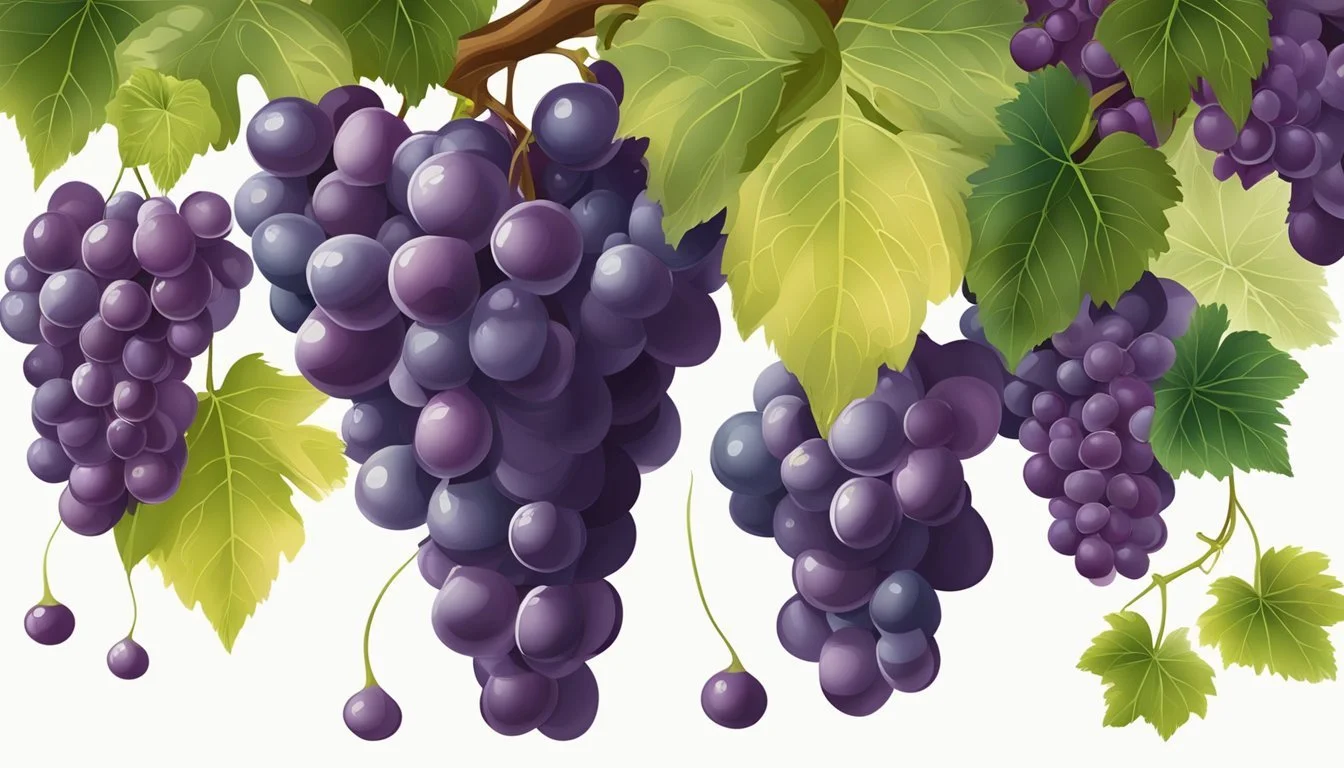How to Tell If Moon Drops Grapes Are Ripe
Your Expert Ripeness Checklist
Determining the ripeness of Moon Drops grapes is vital for enjoying them at their peak flavor and obtaining the best quality fruit. These unique grapes, known for their elongated, tubular shape and sweet taste, have a specific ripeness window that should be recognized for optimal consumption. The ripeness of Moon Drops can be identified through a variety of indicators including color, firmness, and flavor.
Moon Drops have a rich, deep blue hue when ripe with a firm, but not hard texture. A ripe Moon Drop grape will give slightly under pressure, indicating that the sugars within have developed sufficiently to produce a sweet, juicy grape. Taste is the ultimate test of ripeness; a ripe Moon Drop grape should burst with sweetness and lack any tartness, which is common in underripe grapes.
Key Takeaways
Identifying ripeness is crucial for optimal flavor and quality of Moon Drops grapes.
Visual and tactile indicators, such as deep blue color and firmness, can signal ripeness.
The taste test confirms sweetness and readiness for consumption.
Understanding Moon Drop Grapes
Moon Drop grapes are a distinctive variety known for their unique shape and taste. This section explores their origins, characteristics, and nutritional benefits.
Origins and Breeding
Moon Drop grapes are a result of selective breeding by International Fruit Genetics (IFG), not a product of genetic modification. Created in 2004, these grapes are offspring of Vitis vinifera species, a testament to innovative agricultural practices. Grapery, a significant cultivator of Moon Drop grapes, has played a pivotal role in popularizing this fruit, which is now widely grown in California.
Characteristics of Moon Drop Grapes
Physical Appearance: Moon Drop grapes boast a tubular, elongated shape resembling miniature eggplants, with a dark blue-hued skin and pale green flesh.
Flavor Profile: They're cherished for their sweet flavor that comes without the overt tartness sometimes associated with other grape varieties.
Harvesting Period: Moon Drop grapes are typically harvested from August to November, ensuring they reach consumers at peak ripeness.
Nutritional Profile
Moon Drop grapes, like other grapes, are packed with health benefits. They contain a host of nutrients including, but not limited to:
Vitamins: Vitamin K, Vitamin C, and Vitamins A and C.
Minerals: Calcium, Potassium, Iron, and Manganese.
Dietary Fiber: Contributing to digestive health.
Antioxidants: The presence of polyphenols, flavonoids, resveratrol, and anthocyanins in Moon Drop grapes provides powerful antioxidant properties, which may offer protection against various diseases.
By understanding these key aspects of Moon Drop grapes, consumers can appreciate not only the unique taste and appearance of this fruit but also the nutritional advantages it offers.
Pre-Harvest Factors
Successful ripening of Moon Drop grapes depends on specific growth conditions and the ability to recognize when the grapes have reached peak ripeness. These pre-harvest factors are crucial for producing quality fruit.
Growth Conditions
Sunlight: Moon Drop grapes require full sun exposure to develop their sweet flavors optimally. Vines should be planted in locations where they receive at least six to eight hours of direct sunlight per day.
Air Circulation: Good air circulation helps prevent fungal diseases. It's essential to space vines appropriately and manage foliage to promote air flow.
Organic Matter: Soil rich in organic matter ensures healthy growth. Amending the soil with compost can enhance its structure and fertility.
Regional Climate:
Central Valley Region: The Central Valley, and more specifically the San Joaquin Valley and Kern County, provides an ideal climate with hot and dry conditions, pivotal for Moon Drop grape development.
Texas: Texas vineyards also present a suitable environment, given careful site selection to maximize sun exposure and air circulation.
Recognizing Ripeness
Color: Moon Drop grapes should be deep purple, a good indicator of maturity.
Taste and Texture: Ripe grapes will be sweet with a firm yet juicy flesh. Sampling a few grapes can be a reliable test for readiness.
Sugar Content: A refractometer can measure the sugar content, which can guide harvest decisions. Optimal levels vary by intended use (fresh consumption vs. wine production).
Acid Levels: Balance of sugar and acid levels is essential for taste and preservation. Acid testing kits can provide an accurate measure.
Harvesting Moon Drop Grapes
When harvesting Moon Drop grapes, timing and technique play crucial roles in determining the quality and flavor of the fruit. Understanding when to pick and how to handle the grapes will yield the best results.
Optimal Harvest Time
Moon Drop grapes reach peak ripeness in late summer to fall, typically between mid-August and November. Harvesting should commence once they exhibit their characteristic deep purple hue, a sign of full maturation. Grapes should feel plump and firm, with a slight give under gentle pressure. The skins are dark blue, almost black when ripe, and the flesh should appear a translucent pale green.
Harvesting Techniques
During harvesting, one should use sharp, clean shears to snip the stem above the grape cluster, ensuring minimal damage to the vine and the fruit. It's important to handle the clusters carefully to prevent bruising. The grapes should be placed in shallow containers to avoid crushing them under their own weight. For best quality, one should harvest during the cooler parts of the day, such as early morning or late afternoon, which helps preserve their texture and taste until they can be cooled down further for storage.
Post-Harvest Handling
After Moon Drop grapes are harvested, it is crucial to handle them properly to maintain their quality. Effective storage and transport methods are key, as is managing their shelf life for optimal freshness and taste.
Storage and Transport
Moon Drop grapes should be stored in a cool, ventilated environment. The ideal temperature for storage is between 0°C to 1°C (32°F to 34°F) with a relative humidity of 90-95%. For transport, grapes should be kept in temperature-controlled vehicles to prevent spoilage and maintain the desired pH level which is essential for keeping the fruit's natural sweetness and flavor.
Recommended storage practices include:
Keeping grapes in a refrigerator or another cool storage unit immediately after harvest.
Utilizing crates or containers that allow air circulation to prevent moisture accumulation.
Shelf Life
The shelf life of Moon Drop grapes, when stored correctly, can last up to two weeks. It is important, however, to monitor the fruit for any signs of degradation, such as soft spots or mold. Grapes should remain firm to the touch and attached to a healthy-looking stem.
Key points to ensure maximum shelf life:
Checking the storage temperature regularly to avoid fluctuations.
Inspecting the grapes periodically and removing any that show signs of spoilage to protect the remaining bunches.
Selection and Consumption
When picking Moon Drop grapes, one should focus on color, texture, and shape to determine ripeness. Tasting provides insight into the grape’s sweet flavor profile, which is indicative of proper ripeness.
Choosing Ripe Moon Drops
When selecting Moon Drop grapes, one should look for a deep, uniform purple, almost eggplant-like color indicating they are ripe. The grapes should feel firm to the touch, but not hard. Unripe Moon Drops may have a lighter color and firmer texture. The characteristic tubular shape of Moon Drops should be uniform and free of wrinkles, which can signify overripeness or dehydration.
Tasting Notes
Ripe Moon Drop grapes offer a sweet and rich flavor with a pleasant firm texture. They should burst with juiciness when bitten into. The skin is typically thin and not bitter, contributing to the grape's overall enjoyable eating experience. When consumed, one should look for a balance between sweetness and the subtle tartness that Moon Drop grapes are known for. The unique tubular shape not only adds to the visual appeal but may also enhance the tactile experience of eating these grapes.
Health Benefits and Considerations
When assessing the health benefits of Moon Drop grapes, one must consider their nutritional impact and potential role in disease prevention. These factors make Moon Drop grapes not only a delicious choice but also a contributing factor to a balanced diet and better health.
Dietary Impact
Moon Drop grapes are low in calories, with approximately 100 calories per 150-gram serving, making them a smart choice for those monitoring their caloric intake. The nutritional benefits of these grapes are significant due to their content of essential vitamins and minerals. Specifically, they provide up to 15% of the recommended daily intake for vitamin K, which is crucial for bone health and blood clot formation. Other notable nutrients include copper and manganese, which are essential for bone formation and strength.
Caloric Content: Approximately 100 calories per 150 grams
Vitamin K: Up to 15% of recommended daily intake
Minerals: Copper and manganese for bone health
Role in Disease Prevention
Research suggests that the phytochemicals in Moon Drop grapes, such as resveratrol, can play a role in preventing chronic diseases. The presence of antioxidants and polyphenols can help mitigate oxidative stress, thus potentially reducing the risk of cardiovascular disease and certain types of cancer by inhibiting the growth of cancer cells. The consumption of these grapes may also help improve heart health by enhancing blood vessel function, reducing inflammation, and aiding in the regulation of blood pressure. Additionally, the fiber found in these grapes supports digestive health and may help prevent constipation.
Cardiovascular Health: Antioxidants may improve blood vessel function and lower blood pressure.
Cancer Prevention: Potential to inhibit cancer cell growth.
Chronic Diseases: Antioxidants and resveratrol may reduce the risk.
Digestive Health: Fiber assists in preventing constipation.
Culinary Uses of Moon Drop Grapes
Moon Drop grapes, known for their elongated shape and sweet flavor, offer unique culinary applications. They are versatile in the kitchen, easily transitioning from a healthy snack to an intriguing component in various dishes.
Snacking and Desserts
As a snack, Moon Drop grapes provide a satisfying burst of sweetness, making them a delightful choice for both children and adults. Their convenient, seedless nature allows for effortless consumption, whether one is on the go or relaxing at home. For desserts, these grapes can be used whole or sliced in fruit salads, frozen for a cooling treat, or dipped in chocolate for an elegant finish to a meal.
Salads: Toss Moon Drop grapes into salads for a pop of sweetness.
Frozen Grapes: Freeze them for a refreshing, ice-cold snack.
Chocolate Dipped: Dip in dark or white chocolate and chill for a decadent dessert.
Creative Pairings
Moon Drops’ distinctive grape flavor enhances both savory and sweet pairings. They can be a striking addition to cheese platters, contrasting with the saltiness of cheeses such as blue cheese or gouda. In cooking, these berries can be roasted to concentrate their sweetness and added to meat dishes for an unexpected twist.
Cheese Boards: Pair with a variety of cheeses for a balanced flavor profile.
Roasted Grapes: Roast to augment their sweetness and add to savory meat dishes.
Juice Reductions: Utilize their juice in reductions to drizzle over desserts for a natural grape essence.
Agricultural Practices
The correct agricultural practices are vital to ensure the Moon Drop grapes reach optimum ripeness. From precise cultivation techniques to diligent pest and disease control, growers need to employ a series of well-coordinated steps to produce quality fruit.
Cultivation Techniques
Moon Drop grapevines require specific cultivation techniques to thrive. The process starts with cross-pollination techniques, often performed by expert breeders such as International Fruit Genetics to develop this trademarked variety. Once established, growers must ensure:
Proper pruning: This is crucial for controlling vine growth and ensuring sunlight and air can penetrate to ripen the grapes.
Regular watering: Grapevines need consistent watering to develop fully, but it is essential to avoid waterlogging to prevent root diseases.
Effective cultivation also demands strategic plant spacing and positioning to maximize sun exposure, which is essential for ripening.
Pest and Disease Control
Moon Drop grape cultivation must incorporate a pest and disease control strategy. The approach involves:
Regular monitoring: Identifying pests or disease symptoms early can prevent widespread damage.
Integrated Pest Management (IPM): Using a combination of methods, including biological controls, can reduce reliance on chemical pesticides.
For pest control, growers often use netting to protect the grapes from birds. As for diseases, they combat them through fungicides and by selecting disease-resistant plants to minimize the impact. It is crucial to address these issues promptly to safeguard grape quality.
Cultural and Economic Impact
Moon Drop grapes have notably influenced consumer preferences and the viticulture market, especially within regions like California where they are cultivated. They have carved out a distinct niche in grocery stores, including Whole Foods, where they are often sold as a premium variety of seedless grape.
Market Availability
Moon Drop grapes, with their unique elongated shape and sweet flavor profile, have risen in popularity and are typically available in grocery stores, particularly during their peak season, which is a limited time from late summer through fall. California, being a prime region for cultivation due to its ideal climate, contributes significantly to the production and distribution of Moon Drop grapes. Consumers can often find these grapes marketed under innovative brands like The Grapery, which also offers other specialty grapes such as Cotton Candy and Sweet Sapphire grapes.
Cultivar Impact on Grape Industry
The introduction of Moon Drop grapes has been influential in the grape industry, sparking interest in novel grape shapes and flavors. The Grapery's success in developing new cultivars, including the Cotton Candy, Gum Drops, Sweet Sapphire, and Tear Drops varieties, has showcased the potential for non-traditional grapes to capture market share. The impact of such innovations is evident in the trend towards diversifying grape offerings beyond the standard red and black grape varieties, thereby expanding the economic prospects for growers and retailers alike. With a consumer base eager for seedless and uniquely flavored grapes, cultivars like Moon Drop are reshaping industry expectations.
Consumer Advice
When purchasing Moon Drop grapes, consumers should prioritize finding them during peak season and at retailers known for their fresh produce. Ensuring the quality and ripeness will enhance the overall eating experience.
Where to Buy Moon Drop Grapes
Shoppers can typically find Moon Drop grapes at local grocery stores and specialty markets. Stores such as Whole Foods often stock these grapes during their season. It's advisable to check with nearby grocers or use store locators online to find the nearest retailer that carries them.
Dealing with Seasonal Availability
Moon Drop grapes are available for a limited time annually, typically from late August to November. Consumers should take note of this seasonal window and plan their purchases accordingly to enjoy these grapes at their freshest. Outside of this season, finding them can be challenging, and the grapes may not be as flavorful.
Innovations and Future Outlook
In the field of Moon Drop grape cultivation, significant strides are being made in breeding precise traits and improving sustainability. These efforts are focused on enhancing the quality and environmental impact of this unique fruit.
Breeding and Research
Dr. David Cain and his team at International Fruit Genetics (IFG) are at the forefront of breeding innovation. They have developed the Moon Drop grape, a trademarked variety that boasts an elongated, cylindrical shape which sets it apart from traditional grapes. Their ongoing research focuses on achieving a consistent fruit quality that can thrive in the Central Valley region of California, which is known for its ideal grape-growing conditions. The team's selective breeding techniques ensure the Moon Drop grapes remain seedless, retaining their unique and recognizable dimple at the bottom end, which contributes to their sensory appeal.
Sustainability Efforts
Sustainability is another critical component of the future of Moon Drop grape production. Growers, including The Grapery, a key player in the commercialization of Moon Drop grapes, are implementing practices that reduce water usage and chemical inputs. With an eye on preserving the natural resources of the Central Valley region, efforts are made towards:
Water efficiency: Adoption of drip irrigation and other water-saving technologies.
Pest management: Utilization of integrated pest management systems to minimize pesticide use.
Soil health: Improvement of soil composition and fertility through cover cropping and organic amendments.
By prioritizing these areas, growers aim to continue producing high-quality Moon Drop grapes with minimal environmental footprint.





